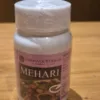Jyothishmati
|
Botanical Name |
Celastrus Paniculatus |
|
Family |
Celastraceae |
|
Sanskrit |
Tejasvini, Supingala, Katabhi |
|
English |
Staff Tree |
|
Hindi |
Malkangani |
|
Kannada |
– |
|
Malayalam |
Polulavam |
|
Telugu |
Teegapalleru |
|
Tamil |
Valulavai |
|
Marathi |
Kangani |
Distribution
Tropical ans subtropical himalayas, bihar and south india
|
Parts Used |
Root Bark, Stem, Seeds |
|
Dose |
Choorna 1-2 G, Oil: 5-15 Drops |
Chemical Constituents
Celapagine, pristimerin, celastrol chemical constituents ayurvedic
Ayurvedic Properties
|
Quality (Guna) |
Laghu, Ruksha, Tikshna |
|
Taste (Rasa) |
Tikta, Madhura, Katu |
|
Metabolism (Vipaka) |
Katu |
|
Potency (Virya) |
Ushna |
|
Impact (Prabhava) |
Chedana |
Pharmacological Action
- It is a powerful brain tonic.
- Respiratory problems, expectorant: reduces productive cough and respiratory disorders.
- It helps in digestive disorders and is an anti tubercular.
Therapeutic Uses
- The decoction of jyothismathi along with brahmi helps in boosting up the memory and acts as a brain tonic.
- The oil of jyothishmati is applied over joints in order to relieve pain and swelling.
- The poultice of the seed is applied topically to cure certain sores, ulcers and skin problems like scabies.
- Nasya is done with jyothishmati oil in order to improve brain functions.
- Jyothishmati kashaya is consumed to increase the renal circulation.
- Insomnia: 5-8 drops of its oil is mixed with a glass of milk in order to improve the quality of sleep.
Some of the common formulations
- Sitopaladi churna
- Eladi rasayana
- Anu taila
- Bala taila
- Bhaskara lavana churna
- Chandraprabha vati
- Brahma rasayana




